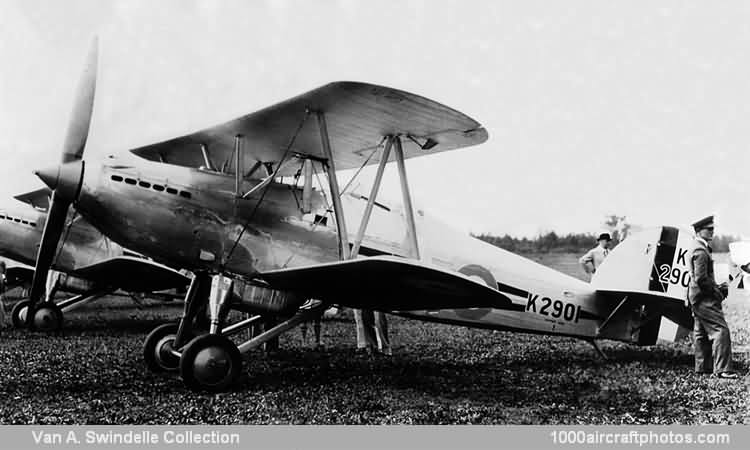07/31/2011. Remarks by Johan Visschedijk: "Achieving the distinction of being the first production warplane to carry level flight performance beyond the 200 mph (322 kmh) mark, the Fury established a level of design elegance entirely new to combat aircraft and fresh standards in handling qualities. The private venture first prototype was flown unregistered in March 1929 as the Hawker Hornet. Powered by a 480 hp Rolls-Royce F.X1 twelve-cylinder liquid-cooled engine (later to be named Kestrel), the prototype was purchased in September 1929 by the Air Ministry under the serial J9682 and renamed Fury.
A contract was placed on behalf of the RAF in August 1930 for 21 aircraft powered by the Kestrel II.S rated at 575 hp at 13,000 ft (3 965 m) and carrying twin 0.303-in (7,7-mm) Vickers machine guns. Production of the initial model (retrospectively designated Fury Mk.I upon the debut of the Fury Mk.II) for the RAF totaled 118 aircraft. A further 112 aircraft powered by the 640 hp Kestrel VI and featuring augmented fuel tankage were procured for the Service as Fury Mk.IIs.
The first production Fury Mk.II for the RAF (produced under sub-contract by General Aircraft) was delivered in July 1936, seven being supplied to South Africa in the following September. Other Fury exports comprised three to Portugal and six to Yugoslavia (essentially similar to the Mk.I); 24 (with Pratt & Whitney Hornet S2B1-G or Bristol Mercury VI.S2) to Iran; one (Armstrong Siddeley Panther IIA) to Norway; three (Hispano-Suiza 12Xbr) with cantilever landing gears to Spain and 10 (Kestrel XVI) with similar landing gears to Yugoslavia. In the last-mentioned country Ikarus and Zmaj built a further 40 under license in 1937-38. Twenty-four ex-RAF Fury Mk.IIs were transferred to South Africa at the beginning of WW II.
Built in the third production batch, this aircraft was one of sixteen produced (s/n K2874 to K2883, K2899 to K2904) to Specification 13/30 under Contract 184968/31. Pictured here in the markings of RAF No. 25 Squadron, K2901 was lost when it collided with K2902 while practicing formation flying over Stansted Park, some 2 mls (3 km) east of Rowlands Castle, Hampshire, UK, on December 17, 1937. Both aircraft crashed, both pilots, Flight Sergeant Robert Edmund Patten and Flight Lieutenant Harry Hamilton Peck were killed."
